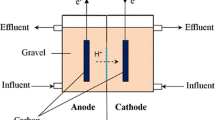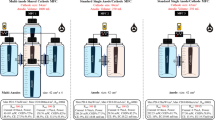Abstract
The present study aimed to improve the performance of microbial fuel cells (MFCs) by using an intermittent connection period without power output. Connecting two MFCs in parallel improved the voltage output of both MFCs until the voltage stabilized. Electric energy was accumulated in two MFCs containing heavy metal ions copper, zinc, and cadmium as electron acceptors by connection in parallel for several hours. The system was then switched to discharge mode with single MFCs with a 1000-Ω resistor connected between anode and cathode. This method successfully achieved highly efficient removal of heavy metal ions. Even when the anolyte was run in sequencing batch mode, the insufficient voltage and power needed to recover heavy metals from the cathode of MFCs can be complemented by the developed method. The average removal ratio of heavy metal ions in sequencing batch mode was 67 % after 10 h. When the discharge time was 20 h, the removal ratios of zinc, copper, and cadmium were 91.5, 86.7, and 83.57 %, respectively; the average removal ratio of these ions after 20 h was only 52.1 % for the control group. Therefore, the average removal efficiency of heavy metal ions increased by 1.75 times using the electrons stored from the bacteria under the open-circuit conditions in parallel mode. Electrochemical impedance data showed that the anode had lower solution resistance and polarization resistance in the parallel stage than as a single MFC, and capacitance increased with the length of time in parallel.








Similar content being viewed by others
References
Abbasi U, Jin W, Pervez A, Bhatti ZA, Tariq M, Shaheen S, Iqbal A, Mahmood Q (2016) Anaerobic microbial fuel cell treating combined industrial wastewater: correlation of electricity generation with pollutants. Bioresour Technol 200:1–7
Abourached C, Catal T, Liu H (2014) Efficacy of single-chamber microbial fuel cells for removal of cadmium and zinc with simultaneous electricity production. Water Res 51:228–233
Armstrong FA (2005) Recent developments in dynamic electrochemical studies of adsorbed enzymes and their active sites. Curr Opin Chem Biol 9:110–117
Biffinger JC, Pietron J, Bretschger O, Nadeau LJ, Johnson GR, Williams CC, Nealson KH, Ringeisen BR (2008) The influence of acidity on microbial fuel cells containing Shewanella oneidensis. Biosens Bioelectron 24:900–905
Cheng CY, Barnard KR, Zhang W, Zhu Z, Pranolo Y (2015) Recovery of nickel, cobalt, copper and zinc in sulphate and chloride solutions using synergistic solvent extraction. Chin J Chem Eng
Choi C, Hu N (2013) The modeling of gold recovery from tetrachloroaurate wastewater using a microbial fuel cell. Bioresour Technol 133:589–598
Choi C, Hu N, Lim B (2014) Cadmium recovery by coupling double microbial fuel cells. Bioresour Technol 170:361–369
Ge Z, Li J, Xiao L, Tong Y, He Z (2013) Recovery of electrical energy in microbial fuel cells: brief review. Environ Sci Technol Lett 1:137–141
Hatzell MC, Kim Y, Logan BE (2013) Powering microbial electrolysis cells by capacitor circuits charged using microbial fuel cell. J Power Sources 229:198–202
He Z, Shao H, Angenent LT (2007) Increased power production from a sediment microbial fuel cell with a rotating cathode. Biosens Bioelectron 22:3252–3255
He Z, Mansfeld F (2009) Exploring the use of electrochemical impedance spectroscopy (EIS) in microbial fuel cell studies. Energy Environ Sci 2:215–219
Hernández-Fernández F, de los Ríos AP, Salar-García M, Ortiz-Martínez V, Lozano-Blanco L, Godínez C, Tomás-Alonso F, Quesada-Medina J (2015) Recent progress and perspectives in microbial fuel cells for bioenergy generation and wastewater treatment. Fuel Process Technol 138:284–297
Karthikeyan R, Selvam A, Cheng KY, Wong JW-C (2016) Influence of ionic conductivity in bioelectricity production from saline domestic sewage sludge in microbial fuel cells. Bioresour Technol 200:845–852
Kubota K, Watanabe T, Yamaguchi T, Syutsubo K (2016) Characterization of wastewater treatment by two microbial fuel cells in continuous flow operation. Environ Technol 37:114–120
Manohar AK, Bretschger O, Nealson KH, Mansfeld F (2008) The use of electrochemical impedance spectroscopy (EIS) in the evaluation of the electrochemical properties of a microbial fuel cell. Bioelectrochemistry 72:149–154
Manohar AK, Mansfeld F (2009) The internal resistance of a microbial fuel cell and its dependence on cell design and operating conditions. Electrochim Acta 54:1664–1670
Papaharalabos G, Greenman J, Stinchcombe A, Horsfield I, Melhuish C, Ieropoulos I (2014) Dynamic electrical reconfiguration for improved capacitor charging in microbial fuel cell stacks. J Power Sources 272:34–38
Ren S, Xia X, Yuan L, Liang P, Huang X (2013) Enhancing charge harvest from microbial fuel cells by controlling the charging and discharging frequency of capacitors. Bioresour Technol 146:812–815
Watson VJ, Nieto Delgado C, Logan BE (2013) Influence of chemical and physical properties of activated carbon powders on oxygen reduction and microbial fuel cell performance. Environ Sci Technol 47:6704–6710
Yuan Y, Zhou S, Tang J (2013) In situ investigation of cathode and local biofilm microenvironments reveals important roles of OH– and oxygen transport in microbial fuel cells. Environ Sci Technol 47:4911–4917
Author information
Authors and Affiliations
Corresponding author
Ethics declarations
Funding
This study was financially supported by the International Science Technology Cooperation Program of China (No. 2013DFR60250), the Natural Science Foundation of China (No. 51408020), and Beijing Municipal Science and Technology Project (Z15111000210000).
Additional information
Communicated by Bingcai Pan
Electronic supplementary material
ESM 1
(DOC 14 kb)
Rights and permissions
About this article
Cite this article
Wang, X., Li, J., Wang, Z. et al. Increasing the recovery of heavy metal ions using two microbial fuel cells operating in parallel with no power output. Environ Sci Pollut Res 23, 20368–20377 (2016). https://doi.org/10.1007/s11356-016-7045-y
Received:
Accepted:
Published:
Issue Date:
DOI: https://doi.org/10.1007/s11356-016-7045-y




